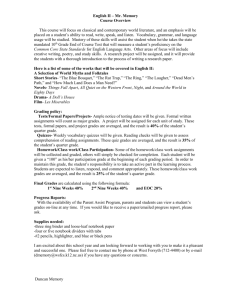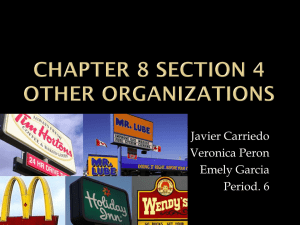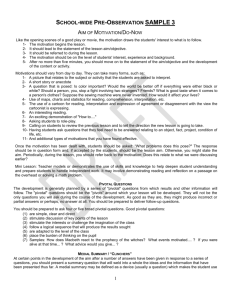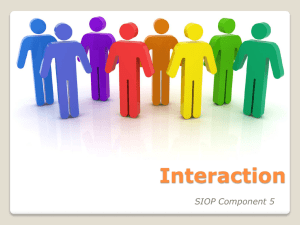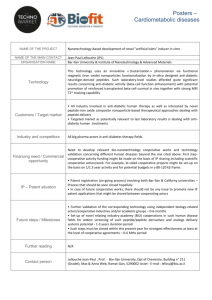Does Group Work Promote A More Cooperative And Educational
advertisement
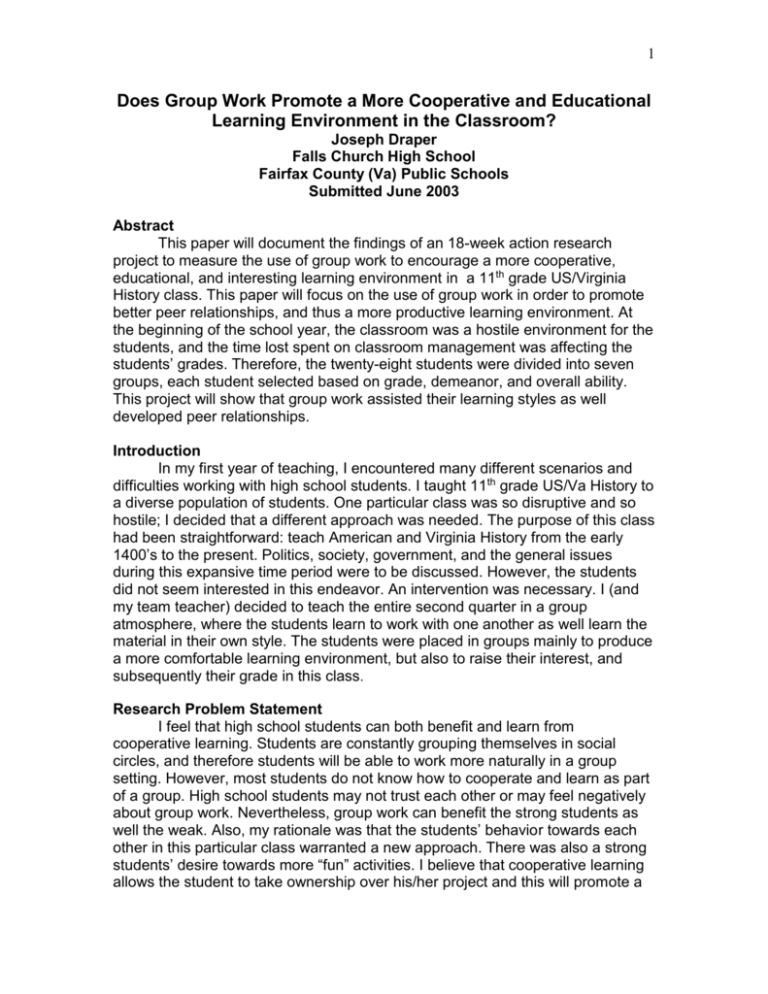
1 Does Group Work Promote a More Cooperative and Educational Learning Environment in the Classroom? Joseph Draper Falls Church High School Fairfax County (Va) Public Schools Submitted June 2003 Abstract This paper will document the findings of an 18-week action research project to measure the use of group work to encourage a more cooperative, educational, and interesting learning environment in a 11th grade US/Virginia History class. This paper will focus on the use of group work in order to promote better peer relationships, and thus a more productive learning environment. At the beginning of the school year, the classroom was a hostile environment for the students, and the time lost spent on classroom management was affecting the students’ grades. Therefore, the twenty-eight students were divided into seven groups, each student selected based on grade, demeanor, and overall ability. This project will show that group work assisted their learning styles as well developed peer relationships. Introduction In my first year of teaching, I encountered many different scenarios and difficulties working with high school students. I taught 11th grade US/Va History to a diverse population of students. One particular class was so disruptive and so hostile; I decided that a different approach was needed. The purpose of this class had been straightforward: teach American and Virginia History from the early 1400’s to the present. Politics, society, government, and the general issues during this expansive time period were to be discussed. However, the students did not seem interested in this endeavor. An intervention was necessary. I (and my team teacher) decided to teach the entire second quarter in a group atmosphere, where the students learn to work with one another as well learn the material in their own style. The students were placed in groups mainly to produce a more comfortable learning environment, but also to raise their interest, and subsequently their grade in this class. Research Problem Statement I feel that high school students can both benefit and learn from cooperative learning. Students are constantly grouping themselves in social circles, and therefore students will be able to work more naturally in a group setting. However, most students do not know how to cooperate and learn as part of a group. High school students may not trust each other or may feel negatively about group work. Nevertheless, group work can benefit the strong students as well the weak. Also, my rationale was that the students’ behavior towards each other in this particular class warranted a new approach. There was also a strong students’ desire towards more “fun” activities. I believe that cooperative learning allows the student to take ownership over his/her project and this will promote a 2 more concerted approach by the student to do their best. The goal of this project is to achieve a more cooperative learning environment, as well increase the student’s level of appreciation for the subject, and thus improve their grade in the class. Students I will be focusing on my first period US/Va History class. There were twenty-eight students in the class with seven of them being special education students. The class meets every other day for ninety minutes and about sixty minutes of that time was devoted to group work. The rest of the time was focused on teacher lectures and quizzes, tests, etc. The students were divided into seven groups, with a special education student in each group. Falls Church is a diverse school, and below is a representation of that diversity. Table 1. Falls Church H.S. – 2002-03 Student Population Ethnic Background Asian Hispanic African American Other The Research The research began with the idea that the cooperative learning method is an important and pivotal role in assessing a student’s ability. A student must be able to work in a team setting but must also work on his/her own to supplement and augment the group project. After reading about the benefits of group work, I was struck by one quote. In Designing Group Work, Cohen states: Social research has gathered impressive evidence to show that when people work together for group goals, there are a number of desirable effects on people’s feelings for one another. When people engage in cooperative tasks, they are more likely to form friendly ties, to trust each other, and to influence each other (Cohen, 1994). Data Collection First, I decided to administer a survey on student’s feelings about group work. Beforehand, however, students were given index cards asking them to write 2-3 people they would like to be grouped with, and 2-3 people that they could not be grouped with at all. The students discussed possible benefits and drawbacks of working together. They also felt that they were more likely to 3 develop peer relationships with their fellow students. As well, they realized what would be appropriate and inappropriate behavior in a group. Mainly though, they were concerned with conflict and equitable distribution of the workload. My data collection started with the students’ first assignment: naming their group. The students decided on common interests and then named their group as they saw fit. Thus, the students form a group identity. Unfortunately, many of the groups had a hard time coming up with a common interest or name. The main parts of the educational aspect of this group project were the events leading up to the Civil War, the actual War, and then the results and explanations of the Civil War. Everyday there were different stations to work at, and then small presentations to the class were given once a week. Students worked efficiently within their groups and took ownership of their roles, and ultimately their grades over the second and third quarters. Survey The survey was administered at the end of the second quarter. In addition, a survey of grades before group work and after group work was taken. Indeed, the results were tremendously encouraging. Results: The students response to group work was overwhelmingly positive. Many students did indicate a preference for working with friends, regardless of ability. Some students admitted that in groups they would let another student take the lead and then would wait for an explanation at the end. The students agreed that their relationships with other students had dramatically improved. Most importantly, grades were generally a letter grade higher at the end of the second quarter than they were at the end of the first quarter. Conclusions Students need instruction in how to work in groups; however, once they did, they took complete autonomy over their projects. Most students prefer to work with friends, but high achieving students appreciate working with others of comparable ability. Individual personality plays a large role in whether someone wants to be part of a group. Some difficulties included different ways of learning between the students (LD/ED, audio, visual learners, etc). Students were quick to dismiss the group work, but most soon saw the benefit of “splitting up the work”. This group work project tremendously improved the classroom environment as many kids sparked an interest in each other and friendships were formed. As well, their interest in the subject matter increased as they took full responsibility for their projects. Ultimately, their grades improved and that is always a success for a teacher. 4 References Cohen, Elizabeth (1994). Designing Group Work: Second Edition. New York: Teachers College Press. Joiner, Richard and Littleton, Karen (2000). Rethinking Collaborative Learning. New York: Free Association Books. Villa, Richard. (1994). Creativity and Collaborative Learning. London: Paul H. Brookes Publishing Co.


